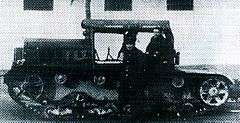C7P
| C7P artillery tractor | |
|---|---|
 The prototype C7P/I (side number 8393) during trials. | |
| Type | Artillery tractor |
| Place of origin |
|
| Service history | |
| In service | 1934 - 1939 (Poland) |
| Used by | Poland, Nazi Germany, Soviet Union |
| Production history | |
| Designer | Witold Jakusz |
| Designed | 1931 - 1934 |
| Manufacturer | PZInż |
| Produced | 1934 - 1939 |
| Number built | 151 |
| Specifications | |
| Weight | 8.5 t |
| Length | 4.60 m |
| Width | 2.40 m |
| Height | 2.40 m |
| Crew | 8 |
|
| |
| Engine |
PZInż. 235 diesel 115 hp |
| Suspension | leaf spring bogie |
Operational range | 150 km |
| Speed | 26 km/h |

C7P (an abbreviation of Ciągnik Siedmiotonowy Polski, "7-tonnes Polish Tractor") was a Polish tracked artillery tractor, used by the Polish Army before and during World War II. The tractor was developed by the design bureau of Witold Jakusz of the PZInż company between 1931 and 1934.
In 1931 Poland bought several dozens of British Vickers E tanks and a license to build additional tanks at home. The Polish Army also considered purchase of the then-constructed Dragon Medium Mk IV artillery tractor, based on the Vickers E, but the purchase never happened. As the British tank was considered not suited for service in Polish climate and needed adaptation, it was decided that a similar Polish tank be built as a modification of the Vickers' design. The tank, initially code-named VAU-33, with time became the 7TP. Simultaneously, works started on a new artillery tractor for the Polish Army that was to replace the Citroën-Kegresse tractors built in France in early 1920s. The main advantage of the new model of artillery tractor, dubbed C6P, C6T and finally C7TP was to be its low price, ease of manufacture and durability. For that purpose, the C7P shared many parts with the 7TP light tank, produced simultaneously. In fact the chassis was almost a direct copy of the tank, while the superstructure was partially borrowed from a license-built Saurer bus.
In 1933 the first two prototypes were constructed in the Ursus factory of the PZInż. The C6P had the engine placed in the front and used front wheel drive, while the C6T had the engine placed behind the crew compartment and used the rear wheel drive. After a series of tests the C6P was chosen as a better option. In fact the new tractor, later redesignated as C7P, was much superior to its contemporary counterparts, particularly the British Dragon Medium Mk IV and the Soviet T-26T, both in terms of power and additional equipment. The final project included a closed crew compartment and a motor-driven winch.
In 1934 the production started. Out of approximately 350 ordered, only 151 were built until the outbreak of World War II. Approximately 108 were deployed to the artillery units, where the C7P was used as an artillery tractor in the regiments of heaviest artillery, mainly for towing of heavy 220 mm wz.32 Škoda mortars. Additional 18 tractors were attached to various tank units, mostly the Polish 10th Motorized Cavalry Brigade for towing of immobilized tanks and for transport of tanks to the battlefield on specially designed towing platforms. Finally, two tractors were delivered to the engineering units for road maintenance and destruction of railways in case of a war. Until 1942 additional 52 were to be delivered to various communal services, where they were to be used as snowplows to keep the roads in good condition in case of a war. During the Polish Defensive War of 1939 all C7P were used in active service. Most were captured by the Germans and were used as towing machines and snowplows at least until 1941.
No example of the C7P survives today. However, a single C7P hull was recovered near Volgograd few years ago. This hull was restored with a BT-5 or BT-7 turret and now looks like a T-26 tank. It is now on display at the Museum of the Great Patriotic War, Moscow, Poklonnaya Gora [1]
Notes
| Wikimedia Commons has media related to C7P. |